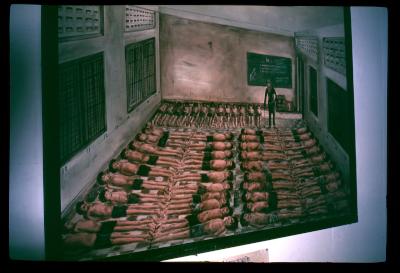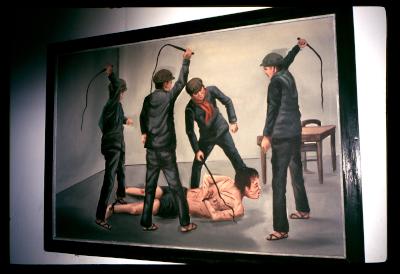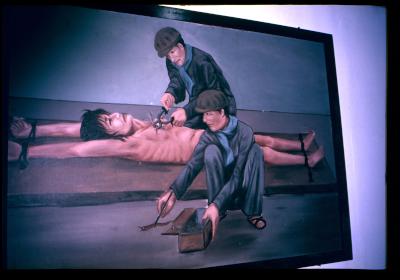Tuol Sleng Survivor Paints Pictures Of His Torture
Tuol Sleng Survivor Paints Pictures Of His Torture
by Richard S. Ehrlich

Click for big version
Vann Nath says he can testify at such a trial and reveal "what I saw and experienced, and what went on in S-21, and I can talk about the prison and what went on there." © Copyright by Richard S. Ehrlich
BANGKOK, Thailand -- Vann Nath is one of seven survivors of Cambodia's Tuol Sleng torture chambers, and escaped when Pol Pot's "killing fields" regime suddenly collapsed in 1979.
Vann Nath is also an artist, and painted graphic pictures of communist Khmer Rouge extracting "confessions" from victims before dumping an estimated 16,000 corpses from Tuol Sleng into more than 100 mass graves.
"Some of my paintings were scenes that I witnessed myself, some were scenes that I heard but did not see, and some were scenes that victims asked me to paint for them, which they had experienced," Vann Nath said in Khmer language during an interview while visiting Bangkok.
One of his paintings shows Khmer Rouge guerrillas swinging a baby by its tiny legs against a blood-stained palm tree, to smash the infant to death.
"That one came from someone who directly saw that, and he requested that I paint that painting," Vann Nath said.
The Khmer Rouge often killed people by beating or starving them to death, to save precious bullets.
Vann Nath said his other paintings document torture he witnessed while imprisoned at Tuol Sleng, which the Khmer Rouge dubbed "S-21", in the heart of Cambodia's capital, Phnom Penh.
"One scene that I myself saw, with my own eyes, is of a man with no clothes who is being carried on a stick like an animal, and others where people are being beaten, and some of the torture," he said, referring to his large paintings.
Traumatized and gaunt, Vann Nath was lucky to emerge alive, thanks to a 1979 blitzkrieg invasion by Vietnamese troops which forced Pol Pot back into the jungle.

Click for big version
"While getting lashes or electrification, you must not cry at all...if you disobey any point of my regulations, you will get either ten lashes or five shocks of electric discharge." © Copyright by Richard S. Ehrlich
Pol Pot died in 1998, after enjoying indirect American support in the 1980s when his ousted Khmer Rouge provided most of the killers in a coalition of Cambodian guerrillas, who helped force Vietnam end its 10-year occupation of Cambodia in 1989.
Today, white-haired Vann Nath, 61, has built a new life, complete with an e-mail address, mobile phone and other modest symbols of success, though he suffers severe kidney disease and undergoes dialysis.
When the U.S. lost the Vietnam War and retreated from neighboring Cambodia in 1975, Pol Pot seized Phnom Penh and force-marched the capital's population into the jungle, claiming the Americans might bomb the city in revenge, and kill everyone.
Historians and analysts, however, say Pol Pot's real motive may have been to hack apart urban resistance to his rural-based guerrillas, and use his fellow Cambodians as slaves to rebuild irrigation canals, roads, and other infrastructure which was destroyed by heavy U.S. aerial bombardment during the war.
Tuol Sleng was formerly a high school during Cambodia's corrupt, U.S.-backed Lon Nol regime.
The Khmer Rouge carved the classrooms into torture chambers and prison cells by bricking up rooms and installing metal shackles.
Vann Nath said he languished for about one month in Tuol Sleng in 1978, accused of offending the regime, before the Khmer Rouge decided they needed an artist to paint official portraits and chisel busts of Pol Pot.
As a result, they unlocked Vann Nath's shackles and demanded he paint several official portraits of Pol Pot, amid the screams of other inmates undergoing interrogations all around him.
Emaciated from a diet of gruel, and using photographs of the secretive Pol Pot to copy, he painted to stay alive while expecting execution.
He never met Pol Pot.
Nor did he meet Michael Scott Deeds, from Long Beach, California, who was caught in 1978 sailing off Cambodia's coast, and executed in Tuol Sleng as an alleged American spy, along with several other foreigners seized in Phnom Penh during Pol Pot's reign.
During the one year Vann Nath endured in the squalid prison, he often saw excruciating, medieval-style torture inflicted on inmates in Tuol Sleng.
After his escape, he picked up his brushes and colors again, and painted the reality of what happened inside Tuol Sleng.
Ironically, some of Vann Nath's most gruesome paintings currently hang near his cell, in what is now a tourist site called The Tuol Sleng Genocide Museum.
Walls in the museum also display black-and-white identification photos of some inmates, who the Khmer Rouge photographed at the prison.
Also displayed are some inmates' skulls.

Click for big version
Tuol Sleng was formerly a high school up until the end of the U.S.-backed Lon Nol regime, which was overthrown by Pol Pot's Khmer Rouge in 1975 when defeated American forces retreated from Cambodia, at the end of the U.S.-Vietnam War. © Copyright by Richard S. Ehrlich
Inside the museum, a sign translated into English lists "the security regulations" told to each prisoner, including the warning:
"Don't be a fool, for you are a chap who dares to thwart the revolution. You must immediately answer my questions without wasting time to reflect.
"While getting lashes or electrification, you must not cry at all...if you disobey any point of my regulations, you will get either ten lashes or five shocks of electric discharge," the sign warns.
The Cambodian government, along with the United Nations and other powers, insist a tribunal is belatedly being set up to determine the guilt of a handful of elderly Khmer Rouge leaders, even though Pol Pot is dead.
Vann Nath said he can testify at such a trial and reveal "what I saw and experienced, and what went on in S-21."
Copyright by Richard S. Ehrlich, a freelance journalist who has reported news from Asia for the past 27 years, and co-author of the non-fiction book, "HELLO MY BIG BIG HONEY!" -- Love Letters to Bangkok Bar Girls and Their Revealing Interviews. His web page is http://www.geocities.com/asia_correspondent
-ENDS-


 Eugene Doyle: The Fall Of Saigon 1975 - Fifty Years Of Repeating What Was Forgotten
Eugene Doyle: The Fall Of Saigon 1975 - Fifty Years Of Repeating What Was Forgotten Peter Dunne: Dunne's Weekly - Trump's Tariffs Still Pose Risks For New Zealand
Peter Dunne: Dunne's Weekly - Trump's Tariffs Still Pose Risks For New Zealand Keith Rankin: Barbecued Hamburgers And Churchill's Bestie
Keith Rankin: Barbecued Hamburgers And Churchill's Bestie Gordon Campbell: On Why The US Stands To Lose The Tariff Wars
Gordon Campbell: On Why The US Stands To Lose The Tariff Wars Eugene Doyle: Before It’s Too Late - Reimagine New Zealand’s Military Future
Eugene Doyle: Before It’s Too Late - Reimagine New Zealand’s Military Future  Binoy Kampmark: Gender Stunts In Space - Blue Origin’s Female Celebrity Envoys
Binoy Kampmark: Gender Stunts In Space - Blue Origin’s Female Celebrity Envoys